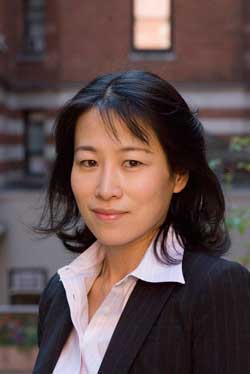Filed Under > TC People
I and Robot
How, really can futuristic gadgets help us learn? Sandra Okita explores the learning partnership between people and technology.
How, really, can futuristic gadgets help us learn? Sandra Okita explores the learning partnership between people and technology
Where others walk through today's toy stores and see high-priced stuff with complicated instructions, Sandra Okita envisions a world where toys and other tools evolve into technological learning partners that expand students' understanding of the world.
Okita, whose expertise spans education, psychology, and human-computer interaction, takes an interdisciplinary approach to the study of technology in education, an area that is thriving at TC. This fall, Okita teaches a course, "Instructional Design of Educational Technology," that examines what features can be built into technology to help kids learn.
"Teachers College is one of the few schools of education today that have an established focus on this kind of interdisciplinary research," Okita says. "The students and faculty are stimulating, adventurous, and open to new ideas. It's a great fit for me."
Okita grew up in California and attended Keio University in Japan, drawn by their strong interdisciplinary program in humanities and computer science. She then earned a master's degree in psychology and a doctorate in education, both from Stanford University. It was there, doing volunteer work in an eating disorders clinic, that she found her true calling to explore the social components of technology. A nurse in the clinic focused on caretaking responsibilities for virtual pets as a way to persuade an anorexic teenager to eat. Okita discovered that through this simple "caring for" and primitive feedback, the child could develop a strong relationship with technology. The child was aware of the consequence of starvation, but knowledge alone did not trigger behavior. What drove her to eat was the strength of this social component, and the relationship she had developed with her virtual pet.
At TC, Okita will investigate how the use of innovative technologies (robots, mixed reality, and real-time distance learning studios) enable students to build a learning partnership with technology, and reveal new insights to the role of social relationships in learning.
"I ask myself, -'What can we learn about the way these children interact with robots that will help us to design technologies that enhance learning? And how can we design robots that actually learn along with students, creating a relationship that is dynamic, so that the robot can anticipate the needs, for instance, of children with learning needs and devise the next step of their learning experience?"
Okita will continue her collaborations with researchers at Honda Research Laboratories, Omron, Sony, and AIST. As she explores the relationships between people and technology, Okita says her ultimate emphasis is always on the human partner. "My interest is to tease out the features that are actually helping children learn more deeply, more individually, more profoundly, and to design technologies that enhance those features," she explains. "I don't care whether the technology is simple or sophisticated. Whatever helps the student learn, that's what is important."
Published Friday, Oct. 10, 2008
